A designer hollers “lunch time” as models — male, female, toddlers and middle-aged — scamper to folding tables, grab a lunch box and plop themselves on the grass. A group of people next to the makeshift catwalk are trying to rearrange a row of bamboo plants brought down from the mountains of Miaoli County. Next to them, a few male models are hanging pieces of Styrofoam cut to resemble clouds over a sign for the Suraw Atayal Fashion Show (森林之心色舞繞泰雅服裝秀), which takes place on Saturday in the county’s Shei-Pa National Park (雪霸國家公園).
A few bamboo plants and Styrofoam clouds smack in the middle of Taipei did not exactly evoke a sense of the thundering mountains and lush greenery that Taian Township (泰安) in Miaoli County, home to the Atayal tribe, is known for. In fact, the entire affair feels more like an informal gathering of friends than preparation for a press conference and fashion show.
Yet I was also grateful for the fact that there weren’t hordes of crazed reporters and fans clawing at each other like you see every year at New York Fashion Week.
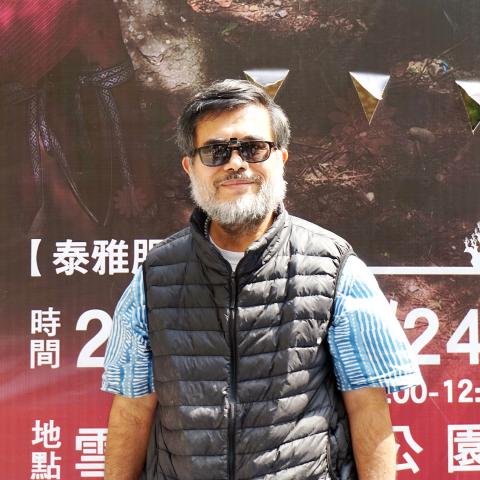
Photo: Dana Ter, Taipei Times
EXCAVATING FASHION
“I’m reluctant to use the term ‘fashion show’ because it comes with certain connotations and expectations,” says Baunay Watan, the event’s organizer and a member of the Atayal community.
Although the ambiance says otherwise, I still expected to see a little fashionista in a big poncho or a lanky man with skinny pants rolled up at the ankles, so am slightly shocked when I find Baunay to be a middle-aged man with a grizzly beard.
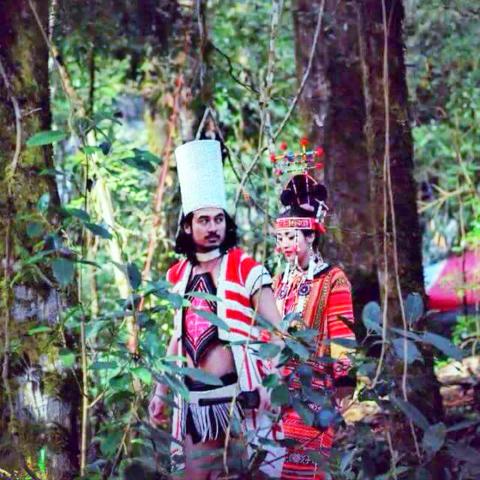
Photo courtesy of Luo Hsiao-fang
Baunay, who has been traveling around Taiwan photographing Atayal clothing for nearly 20 years, opened a workshop in 2012 with his wife Yuma Taru. Together, they seek out designers to create designs inspired by the traditional ones they have photographed. Some designers follow the traditional Atayal red-and-white shawls with intricate embroidery, while others embed Atayal motifs in flowing dresses and snug sweaters.
Baunay says their workshop has created jobs in their community, and their annual fashion show has helped to garner interest in Aboriginal culture. While his employees are mostly Atayal, the designers and models are a mixture of Aborigines from other communities and other Taiwanese.
Every year, the fashion show attracts designers from overseas. This year’s line-up includes designers from Japan, South Korea and Russia.
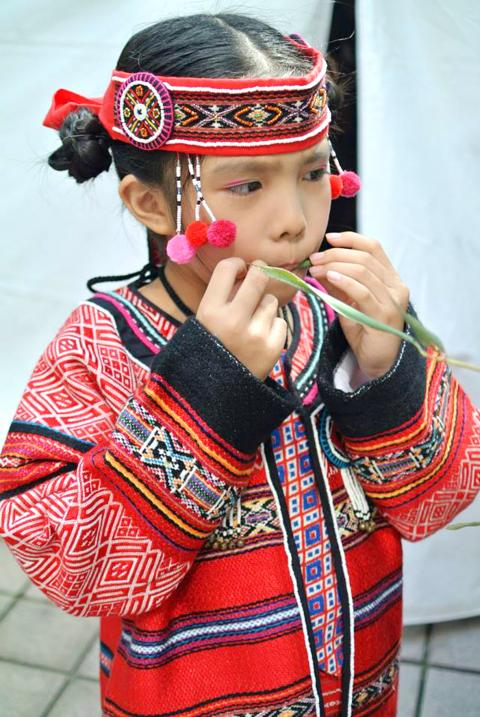
Photo courtesy of Bui Hoang Nga
“We consciously chose not to hold the show in Taipei,” Baunay says. “We wanted a more authentic setting.”
Although it would be more convenient for most people to attend a show in Taipei, Baunay says the idea was to have it in the woods that inspired the designs in the first place.
INVALUABLE LESSONS
As we chat under the shade, Baunay’s kindergarten-age daughter, who is also one of the models, pops up behind him and mumbles something in his ear. She has a full face of makeup and her hair is done up in two buns.
“Fashion is an important way for our people, especially the youth, to better connect to our culture,” Baunay says.
Indeed, fashion shows are a community affair for the Atayal residents of rural Taian Township. Children as young as two years old strut down the “runway” — a clearing in a forest — dressed in embroidered vests and beaded headbands. Even at the Taipei press conference, the children are all smiles, practicing songs in Atayal and working the catwalk with the adult models.
Baunay hopes that being exposed to their culture at a young age will mold their way of thinking in the future. Knowing it’s inevitable that young people will move out of their communities in search of better job opportunities in the city, Baunay’s wish is for them to learn how to integrate into non-Aboriginal society without forgetting their roots.
“Perhaps they can even teach other young people a bit about Atayal culture through donning their traditional clothes from time to time,” Baunay says.
But there are some who don’t understand his intention of making fashion — a term that automatically connotes snobbery and elitism — inclusive and participatory.
“They come to Miaoli thinking it’ll be like fashion week in New York, London or Paris, and are taken aback to discover that it isn’t set up like that,” Baunay says.
Their priority is not to make money, as they aren’t selling any of their clothes, at least not yet. Their models are not all young, tall and skinny. Instead of promoting a certain image or lifestyle, the fashion show serves as a starting point to get people interested in learning more about other facets of Aboriginal culture, including languages, customs and cuisines.
“The clothes may not be considered ‘fashionable’ in the aesthetic or conceptual sense, but they have educational value,” Baunay says.
As for future shows, he hopes to continue to garner a global audience until one day people will start associating Aboriginal clothing as one of Taiwan’s national clothes. But for now, Baunay and his team are content with doing what they do, taking rehearsals light-heartedly and knowing when to stop and indulge in a hearty, greasy lunch box.
For more information about Saturday’s Suraw Atayal Fashion Show, visit their Facebook page (Chinese) at zh-tw.facebook.com/LIHANGWORKSHOP.
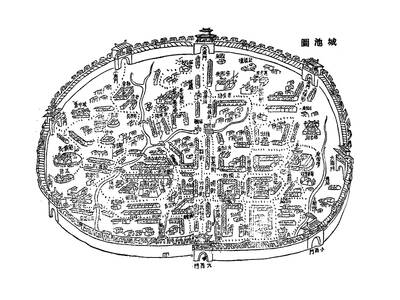
May 26 to June 1 When the Qing Dynasty first took control over many parts of Taiwan in 1684, it roughly continued the Kingdom of Tungning’s administrative borders (see below), setting up one prefecture and three counties. The actual area of control covered today’s Chiayi, Tainan and Kaohsiung. The administrative center was in Taiwan Prefecture, in today’s Tainan. But as Han settlement expanded and due to rebellions and other international incidents, the administrative units became more complex. By the time Taiwan became a province of the Qing in 1887, there were three prefectures, eleven counties, three subprefectures and one directly-administered prefecture, with

Taiwan Power Co (Taipower, 台電) and the New Taipei City Government in May last year agreed to allow the activation of a spent fuel storage facility for the Jinshan Nuclear Power Plant in Shihmen District (石門). The deal ended eleven years of legal wrangling. According to the Taipower announcement, the city government engaged in repeated delays, failing to approve water and soil conservation plans. Taipower said at the time that plans for another dry storage facility for the Guosheng Nuclear Power Plant in New Taipei City’s Wanli District (萬里) remained stuck in legal limbo. Later that year an agreement was reached

What does the Taiwan People’s Party (TPP) in the Huang Kuo-chang (黃國昌) era stand for? What sets it apart from their allies, the Chinese Nationalist Party (KMT)? With some shifts in tone and emphasis, the KMT’s stances have not changed significantly since the late 2000s and the era of former president Ma Ying-jeou (馬英九). The Democratic Progressive Party’s (DPP) current platform formed in the mid-2010s under the guidance of Tsai Ing-wen (蔡英文), and current President William Lai (賴清德) campaigned on continuity. Though their ideological stances may be a bit stale, they have the advantage of being broadly understood by the voters.
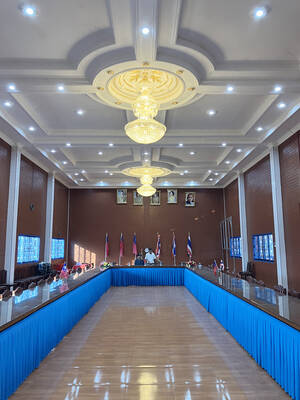
In a high-rise office building in Taipei’s government district, the primary agency for maintaining links to Thailand’s 108 Yunnan villages — which are home to a population of around 200,000 descendants of the Chinese Nationalist Party (KMT) armies stranded in Thailand following the Chinese Civil War — is the Overseas Community Affairs Council (OCAC). Established in China in 1926, the OCAC was born of a mandate to support Chinese education, culture and economic development in far flung Chinese diaspora communities, which, especially in southeast Asia, had underwritten the military insurgencies against the Qing Dynasty that led to the founding of